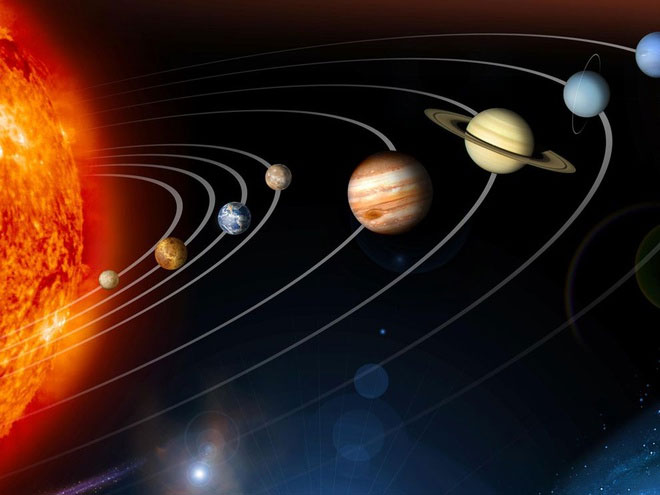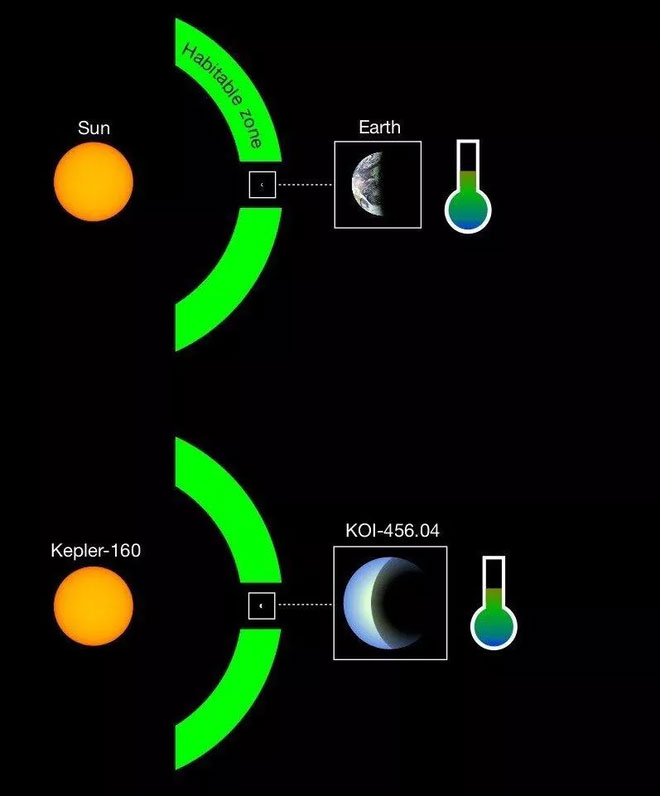Find the 'mirror image' of the Solar System
An alien planetary system orbiting the star has been found to have many similarities to the Earth and the Sun.
A team of the Max Planck Solar System Research Institute (Germany) has discovered KOI-456.04 , an alien orbiting the red dwarf star Kepler-160.
About 3,000 light-years away, the data shows they have many similarities to Earth and the Sun. In other words, it is like the "mirror image" of the Solar System.
The research results were published in June 4 in the journal Astronomy & Astrophysics.

The exoplanetary system that orbits the recently discovered host star has a lot of similarities to the Solar System. (Photo: National Geographic).
Exoplanets are planets outside the Solar System. According to CNET, the Max Planck Institute describes KOI-456.04 as an "not only habitable exoplanet ", the light from its host star being very similar to the light from the Sun hitting the Earth.
Not only that, the orbit of KOI-456.04 is similar to the planet we live in, with a size almost twice the size of Earth.
Most Earth-like exoplanets (in size) ever found orbiting red dwarfs, however, the light from them makes the planets nearly impossible to live.

Compare exoplanet KOI-456.01 and host star Kepler-160 with Earth and Sun. (Photo: René Heller / MPS).
Meanwhile, host star Kepler-160 projects light in the spectrum (visible) rather than infrared. In addition, it is quite similar to the Sun in terms of size and surface temperature.
The scientists also found two exoplanets orbiting Kepler-160 but with very low viability. They suggest that there are four planets orbiting the Kepler-160 system, of which KOI-456.04 is in a habitable zone because liquid water can exist on its surface.
René Heller, a researcher at the Max Planck Institute, said that KOI-456.01 is relatively large compared to the Earth-like exoplanets found, but what is especially significant is its association with a star. The host star is quite similar to the Sun.
Of course, many factors are needed to determine whether a planet can survive. For a star, it depends on the atmosphere, not just the surface temperature or the light.
According to Futurism, it is unlikely that KOI-456.01 is a planet because the identification system may be faulty, but the team believes it is 85% more likely.
Scientists hope future space telescopes like the European Space Agency's Plato can identify this exoplanet.
- The invention of a mirror with a much wider viewing angle than a conventional mirror
- The mirror of the
- Unique mirrors smile only 'show up' when people laugh
- There is a solution to split the mirror image on the image
- Why does the mirror image turn back from left to right, but not upside down?
- Why do we find ourselves most beautiful in the mirror?
- The bizarre solar gun of Germany
- Inventing: Mirror to help the owner
- The Solar System has never been this beautiful
- Discover the oldest solar system outside the solar system
- Monstrous test: What if it is possible to photocopy a mirror
- Beautiful photo from the Solar System
 Van Allen's belt and evidence that the Apollo 11 mission to the Moon was myth
Van Allen's belt and evidence that the Apollo 11 mission to the Moon was myth The levels of civilization in the universe (Kardashev scale)
The levels of civilization in the universe (Kardashev scale) Today Mars, the sun and the Earth are aligned
Today Mars, the sun and the Earth are aligned The Amazon owner announced a secret plan to build a space base for thousands of people
The Amazon owner announced a secret plan to build a space base for thousands of people The 'red monster' that Sima Qian mentioned caused illusions on Earth?
The 'red monster' that Sima Qian mentioned caused illusions on Earth?  This fruit has a sweet and sour taste that is as good as 'natural insulin', helping to lower blood sugar and nourish bones effectively.
This fruit has a sweet and sour taste that is as good as 'natural insulin', helping to lower blood sugar and nourish bones effectively.  A shooting star, about to explode in the sky of Earth?
A shooting star, about to explode in the sky of Earth?  Image of a new star spewing gas loudly across the Milky Way galaxy
Image of a new star spewing gas loudly across the Milky Way galaxy  The 'deadly' truth about strange radio signals transmitted to Earth
The 'deadly' truth about strange radio signals transmitted to Earth  Scientists Stunned to Discover Star With Supersonic Tsunamis Three Times Higher Than the Sun
Scientists Stunned to Discover Star With Supersonic Tsunamis Three Times Higher Than the Sun 